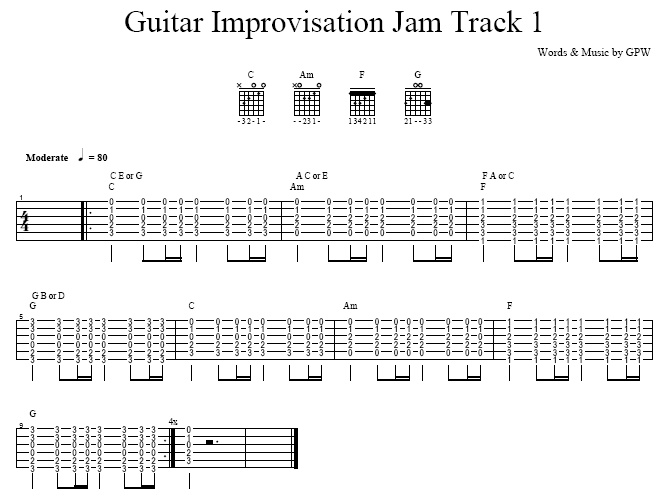Using Backing Tracks for Improvisation
 Backing tracks are a great way to increase your guitar playing skills. Not only do they give you a foundation to build on, but they also help you to improve your timing and creativity.
Backing tracks are a great way to increase your guitar playing skills. Not only do they give you a foundation to build on, but they also help you to improve your timing and creativity.
When you play with a backing track, there are a few things you should keep in mind. First off, you should try to keep track of which patterns you are using.
Although familiar patterns may seem great at first because they are, well, familiar, it is easy to get stuck in a loop playing the same patterns over and over.
Approach a backing track as you would approach any other type of song. Take your time to discern the key of the piece, and then once you have, study the piece. Try to envision what techniques you would like to emphasize in certain parts.
This is important, as many guitarists overwhelm themselves and try to throw all of their skills out at once. Not only does this destroy any chance of building up, but it may also cause discouragement. Be conservative.
Improvisation Over Chord Progressions in C Major
I know a lot of online lessons that simply tell you to use certain scales for soloing over chord progressions and leave you hanging there. In my own experience, I find that learning the scales isn’t a difficult process.
The most difficult part is understanding what notes to play and when to play them through the course of a music piece. In this exercise, I’m going to use a familiar progression: | Cmaj | Amin | Fmaj | Gmaj | to explain the basics of soloing. In case you didn’t know yet, the key of this progression is in C major.
Remember, There Are Some Rules to Follow…
When I first started learning the lead guitar, I found it to be very confusing as many lessons and “gurus” me kept mentioning that the C major scale can be used freely to solo over a particular chord progression.
Technically speaking, we could use the C major scale over the chord progression with no possible wrong notes. However, if the notes of the C major scale are randomly played across the chord progression, you’ll realize that there are some notes which just don’t sound right over certain chords.
Test it out for yourself.
The reason why some of the notes sound “wrong” is due to dissonant tones created by clashing intervals. For example, if you play an F or A note over C major chord, the notes don’t seem to sound right on the C major chord.
For a start, the easiest way to begin is to always land on “safe” notes on each chord change. The “safe” notes of the C major chord are C E G; “safe” notes of Amin are A C E etc…… In a nutshell, landing on notes that make up the chords you are soloing over are SAFE and will generally sound good.

Download .gtp5 ( Right-click Save Target as… )
After you had downloaded the .gtp5 file, you can access an example of a simple solo that I played across the chord progression. What I want you to do now is to use the jam track and play your own solos over it.
For a start, don’t worry about playing a fancy solo. Instead, I want you to focus on landing on safe notes during the chord changes.
Setting Your Goal When Using Backing Tracks
When I use a backing track for improvisation, I like to set a goal. If I am playing along to a jazz piece, I like to outline a vague pattern once I have discovered the key of the piece. There are also a few things to take into consideration; regardless of the key, do I want to follow in chromatics or use a regular structured scale?
This is important as I can either rule out certain notes or rule in free reign over my choice of notes. I suggest you ask yourself similar questions while you listen to the track for the first time.
Planning your improvisation is an invaluable skill; I know of very few guitarists who go into an improvisation without at least some simple, basic notion of what they are going to follow.
Creating Your Own Style And Musical Signature
Another great skill that can be gained by playing along to backing tracks is the ability to play various styles in your own way. Many players try to mimic other musicians when they play their songs, but with a backing track, there is no voice to mimic. You have complete and utter control over how you will play.
This can be an eye opening experience for many musicians, beginners and advanced alike. Many of us see ourselves as much more diverse players than we truly are. Not only can various styled backing tracks help us to see our true strengths and weaknesses, they can also show us how much we have really been able to develop our own style.
Explore Other Genres And Styles
If you find that all of the licks you fall into are ones you have copied from other players, you may want to focus more on backing tracks to develop your own guitar licks.
If you find yourself having trouble playing along to a blues track because you focus most of your time practicing neoclassical guitar, then you know you need time to practice other styles to round out your playing.
As long as you create an outline, a goal, or a mission when approaching a backing track, you will see a large improvement in your improvisations.
Keep in mind that improvising entails playing the given style even if you add your own flare and as mentioned above, throwing yourself on the mercy of a jam track can really open your eyes to your adaptability and skill level. As with everything, when playing along to a backing track, above all be sure to have fun and stay aware of repetition.
Guitar Lessons Guaranteed to Help You See Massive Improvements!

Jamplay is the BEST online guitar lesson website that offers step-by-step videos in high definition. They cover EVERY genre of guitar styles and have exhaustive content for musicians of any skill level.
Jamplay also showcases a continuously growing archive of video lessons that are updated weekly. In addition to that, they also offer detailed tutorials for members to learn popular songs with the help of precise, dynamic tabs and song visualizations.
p.s: We have set up a wonderful deal for GuitarPlayerWorld.com’s visitors. Get your exclusive Jamplay promotion code here…






Leave A Comment